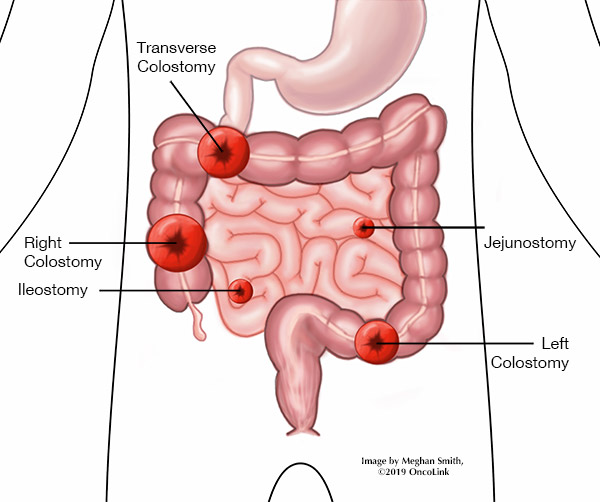
Living with a Bowel Ostomy
What is a bowel ostomy?
An ostomy is when surgery is done to make an opening from the inside of the body to the outside. A bowel ostomy is when a connection is made from the bowel to the abdominal (belly) wall. A bowel ostomy will change where your stool (bowel movement) leaves the body. The stool passes through an opening in the abdominal wall, called a stoma, to outside of your body.
- When the connection is to the colon, it is called a colostomy.
- When the connection is to the small bowel (ileum or jejunum), it is called an ileostomy or a jejunostomy.
If part of your bowel has disease in it or if it is not working as it should, you may need a bowel ostomy. In some cases, your bowel ostomy is temporary (short-term), and the bowel can be reconnected later. In some cases, it is permanent (long-term).
How does a bowel ostomy work?
Stool moves through your bowel and it empties stool past the stoma in your abdominal wall. A bag attached to your abdominal wall outside the body catches the stool. You will need to empty or change this bag.
The consistency of your stool (how it looks and feels) depends on where in the bowel the ostomy is placed. The further down in the bowel, the more formed the stool will be. For some people, bowel movements can be regular and you may not need to wear a bag all the time.
How do I care for the stoma?
It is important to take care of the stoma and the skin around it to prevent problems and skin breakdown. An ostomy nurse can teach you how to care for the skin and place the bag. Look at the stoma for changes in color or swelling. Report any changes to your healthcare provider right away. If the skin around the stoma changes in color (becomes red) or inflamed , call your care team or ostomy nurse.
What is it like to live with a bowel ostomy?
An ostomy can be a life-long change that can come with psychological problems, skin problems around the stoma, and relationship concerns. It can take time to get used to life with an ostomy. Many people feel alone after ostomy surgery and are unsure of how they will enjoy life again. Remember, many people live long, healthy and fulfilling lives with an ostomy! Meeting with a support group or support person can help you see how fulfilling life can be and can teach you ways to learn what works best for you.
Can I have a normal sex life with an ostomy?
You may have sexual health changes and worries about your physical appearance. This will often get better as you get used to the changes and figure out how to take care of your ostomy. Using a cloth, sash, or pouch cover to cover the pouch during intimate moments can help. Choosing sexual positions that are comfortable and have less pressure on the bag can prevent problems or leakage.
Where can I find support for living with an ostomy?
- An ostomy nurse can help with ostomy care, including skincare, bag selection and use, issues, and changes in the stoma over time. Ask your care team to help you find an ostomy nurse you can call if issues come up.
- Many people find comfort in a support group, whether it is in person or online. There are quite a few online communities that can help with the issues you might face (just search for "ostomy support"). Some places have peer-to-peer support as well, where you talk one on one with someone else who has an ostomy.
- If you have an ostomy, it is helpful to find a group or healthcare provider you can turn to for information and help, as issues can come up years after getting the ostomy and you need to know where to turn for help.
Resources for Ostomy Support
These websites provide helpful information about dealing with the many concerns related to having an ostomy.
United Ostomy Associations of America, Inc. - https://www.ostomy.org/
Wound Ostomy and Continence Nurses Society - https://www.wocn.org/
Ostomy Canada Society - https://www.ostomycanada.ca/
American Society of Colon and Rectal Surgeons - https://www.fascrs.org/patients/disease-condition/ostomy-0
OncoLink is designed for educational purposes only and is not engaged in rendering medical advice or professional services. The information provided through OncoLink should not be used for diagnosing or treating a health problem or a disease. It is not a substitute for professional care. If you have or suspect you may have a health problem or have questions or concerns about the medication that you have been prescribed, you should consult your health care provider.
Information Provided By: www.oncolink.org | © 2025 Trustees of The University of Pennsylvania
